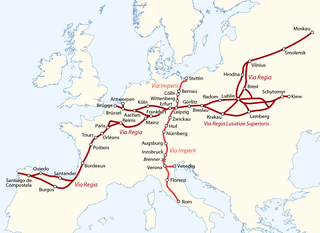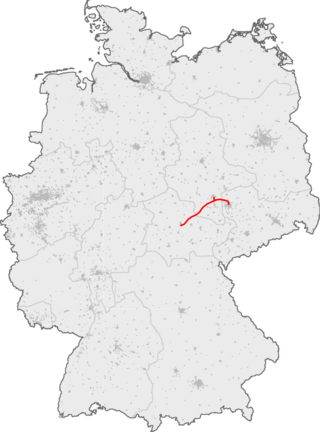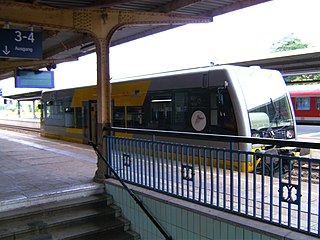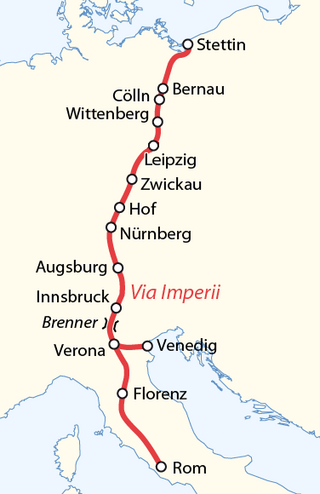
Leipzig, with a population of 624,689 inhabitants as of 2022, is the most populous city in the German state of Saxony, the second most populous city in the area of the former East Germany after (East) Berlin, and Germany's eighth most populous. Leipzig/Halle Airport is situated in Schkeuditz, between Leipzig and Halle (Saale). The name of the city and those of many of its districts are of Slavic origin.
Central Germany is an economic and cultural region in Germany. Its exact borders depend on context, but it is often defined as being a region within the federal states of Saxony, Thuringia and Saxony-Anhalt, or a smaller part of this region, such as the metropolitan area of Leipzig and Halle plus the surrounding counties.

Leipzig/Halle Airport is an international airport located in Schkeuditz, Saxony, Germany, and serves both Leipzig, Saxony, and Halle, Saxony-Anhalt.

The Via Regia is a European Cultural Route following the route of the historic road of the Middle Ages. There were many such viae regiae associated with the king in the medieval Holy Roman Empire.

The Erfurt–Leipzig/Halle high-speed railway is a 123 km (76 mi)-long high-speed line in Germany between Erfurt and Leipzig and Halle.
Mittelsachsen is a district (Kreis) in the Free State of Saxony, Germany.

Halle (Saale) Hauptbahnhof is the main railway station in the city of Halle (Saale) in southern part of the German state of Saxony-Anhalt. The station is situated east of the city centre and is a category 2 station.

The Berlin–Halle railway, sometimes called the Anhalt railway, is a twin-track, electrified main line found in the German city and state of Berlin, and the states of Brandenburg and Sachsen-Anhalt. The railway was originally built and managed by the Berlin-Anhaltische Eisenbahn-Gesellschaft.

The Bundesstraße 6 is a German federal highway running from Bremerhaven on the North Sea coast in a southeasterly direction through the states of Lower Saxony, Bremen, Saxony-Anhalt and Saxony to Görlitz on the Polish border.
The Halle–Bebra railway, known in German as the Thüringer Bahn, is a 210 kilometre-long railway line from Halle (Saale) via Erfurt and Gerstungen to Bebra, mainly in Thuringia. As far as Gerstungen the line originally belonged to the Thuringian Railway Company. From Gerstungen to Bebra, it was owned by the Frederick William Northern Railway (Friedrich-Wilhelms-Nordbahn), named after the Prussian king, Frederick William IV. It is now a two-track, electrified, standard gauge mainline operated by DB Netze. It was opened between 1846 and 1849 and was the first railway line in Thuringia. All types of trains from Regionalbahn to ICE currently run on the line except Interregio-Express. Four of the six largest cities in Thuringia are located on the line.

The Trebnitz–Leipzig railway is a double track electrified main line in the German states of Saxony-Anhalt and Saxony built and originally operated by the Berlin-Anhalt Railway Company. It formally starts at Trebnitz on the former border between the Duchy of Anhalt and Prussia and runs via Dessau and Delitzsch to Leipzig. The section from Bitterfeld to Leipzig is part of Line 1 of the Trans-European Transport Networks (TEN-T). Until 1871, the Zerbst–Roßlau section was called the Anhaltische Leopoldsbahn.

In medieval times, imperial roads were designated routes in the Holy Roman Empire that afforded protection to travellers in return for tolls collected for the emperor.
The Hamm–Warburg railway is a 131 km long main line railway in the German state of North Rhine-Westphalia. It is part of an east-west line, known as the Mid-Germany Connection, and is served by InterCity trains between the Ruhr and Kassel, Erfurt and Berlin. In addition, there are dense freight and regional services. The line was opened between 1850 and 1853 and is one of the oldest railways in Germany.

The Weißenfels–Zeitz railway is a single-track main line railway in the south of the German state of Saxony-Anhalt. It runs from Weißenfels via Teuchern to Zeitz. It was one of the main lines of the networks of Burgenlandbahn, a subsidiary of DB Regio, and is now served by DB Regio Südost.

Via Imperii was one of the most important of a class of roads known collectively as imperial roads of the Holy Roman Empire. This old trade route ran in a south–north direction from Venice on the Adriatic Sea and Verona in the Kingdom of Italy across the Brenner Pass through Germany to the Baltic coast passing the following cities:

S-Bahn Mitteldeutschland represents an enlargement of the previous Leipzig-Halle S-Bahn. It is an electric rail public transit system operating in the metropolitan area of Leipzig-Halle, Germany. This S-Bahn network developed from two separate S-Bahn networks of Halle (Saale) and Leipzig, which were established separately in 1969 and then linked in 2004. With the opening of the Leipzig City Tunnel on 15 December 2013 as a new artery, the network was extended for the first time to the federal states of Thuringia and Brandenburg. With a system length of 802 km (498 mi), it is the largest S-Bahn network in Germany, displacing the long-time title holder Rhine-Ruhr S-Bahn from that position. The locomotive-hauled double-decker trains partly dating back to the DDR-era have been largely replaced by electric multiple unit Bombardier Talent 2 trains, but some are still used during rush hour.

The Bundesstraße 87 is a Bundesstraße in Germany. It begins in Ilmenau and ends in Frankfurt (Oder). In Thüringia it runs partly along the Straße der Romanik.
The Halle–Cottbus railway is a 176 km long double-track electrified main line in the German states of Saxony-Anhalt, Saxony and Brandenburg. It was opened in 1871 and 1872. It formed the central section of the network of the Halle-Sorau-Guben Railway Company. Today it is part of a connection between the Central Germany and Poland.

Jüterbog station is a station in the town of Jüterbog in the German state of Brandenburg. It was opened in 1841, which makes it one of the oldest railway stations in Brandenburg. The Jüterbog–Röderau railway has branched off the Berlin–Halle railway (Anhalterbahn) at the station since 1848. Its importance grew with the opening of further railway lines. Some of these lines have now been closed.














